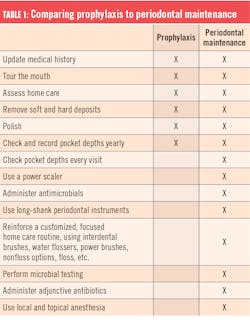Prophy versus perio maintenance: What’s the difference?
Dear Dianne,
I recently had a very uncomfortable situation involving a periodontal maintenance patient. When I finished her appointment, she went to the business desk to check out. When she was told the fee for her periodontal maintenance visit, she went ballistic. She loudly proclaimed that I had not done anything differently than when she got a “regular cleaning” and that she felt we were ripping her off. Then she refused to pay the periodontal maintenance fee. She said she would only pay for a “regular cleaning” since that’s what she got. I did not go to the business desk while she was there, but after the patient left, the business assistant came back to my operatory and asked for details. Specifically, she asked how treatment for periodontal maintenance differs from a prophy. I had a hard time describing any difference in the care I provide for prophy patients versus periodontal patients. I guess nobody had ever really questioned it before.
I try to do my best with patient care, but maybe this ought to be a wake-up call for me. I certainly do not want this to happen again, nor do I want any patient to feel as though he or she is not receiving high-quality care. Can you help me sort this out? How should a periodontal maintenance visit differ from a regular prophy visit?
—Deep South RDH
Dear Deep South,
Thank you for writing and sharing this dilemma. Many hygienists perform exactly the same procedures for a prophylaxis as they do for periodontal maintenance. It’s only natural for patients to balk at paying higher fees when there doesn’t seem to be any difference between a periodontal maintenance appointment and a prophylaxis appointment. I believe several factors contribute to this patient perception, so let’s see if we can break this down.
First of all, I want you to consider the difference between preventive care and therapeutic care. A prophylaxis is a preventive procedure intended to prevent disease and should be used only for people who do not exhibit any of the signs and symptoms of periodontal disease, including bone loss, bleeding, mobility, and/or exudate. If a patient already has signs and symptoms of disease, it is too late to prevent it, right? Unfortunately, it appears that hygienists regularly provide preventive care to patients already exhibiting signs of disease. The problem is the indecision that hygienists face when there is a mixture of healthy sites and disease sites. The default is to do the prophy and move on. After all, the typical hygienist has a pressing schedule that doesn’t make it easy to switch gears. Old habits die hard!
Therapeutic care is different in that it is meant to maintain the results of periodontal therapy, not to prevent disease in healthy patients. The definition of therapeutic is “of or relating to the treating or curing of disease; curative.”1 So, the focus is different. Some patients have great success after a year or two of definitive maintenance and reach a point where they have no signs or symptoms of active disease (i.e., little if any bleeding on probing and no continuing loss of bone or attachment). Patients in this category do not smoke and have very good to excellent oral hygiene. Other patients never get to the point of having no signs or symptoms of disease. Maintenance patients who have poor oral hygiene, smoke, and continue to exhibit bone loss and/or excessive bleeding have not achieved an acceptable level of stability and good health. Such patients should be seen by a periodontist and may need D4910 maintenance indefinitely after definitive treatment.
Let’s think about the differences in treatment protocol between a prophy and a periodontal maintenance appointment (table 1). In both procedures, there are common duties, such as updating the medical history, assessing the patient’s level of oral hygiene, scaling and polishing, and providing oral hygiene instructions. However, the periodontal maintenance appointment is focused on actively treating disease. Think of it like exploring a dark cave with no flashlight and nothing but your hands to find your way. You must feel every nook and cranny with appropriate instruments and ascertain the topography while identifying and removing accretions that are responsible for harboring all kinds of pathogens. With periodontal maintenance patients, you are fighting an unseen microbial enemy. Depending on disease severity, periodontal patients will repopulate with pathogens in as little as a month following debridement, so strategies aimed at microbial control are important in controlling the real enemy. Power scalers with long, thin tips are quite helpful in debriding and flushing deep pockets. Calculus removal should be a combination of power and hand scaling for the most thorough debris removal. Remember that microbes do not prefer calculus over cementum and will stick anywhere in the sulcular area, including the nonkeratinized epithelium.
In addition, periodontal patients will benefit from adjunctive antimicrobials, such as molecular iodine, sodium hypochlorite, or chlorhexidine, as needed. Many hygienists have found that cooling the tip of the power scaler with an antimicrobial while debriding is a great way to deliver powerful adjuncts to deep subgingival areas. Hygienists who do not have an external water supply bottle may find that using an irrigator postscaling is a good way to deliver an antimicrobial.
Another important part of a periodontal maintenance visit is the reinforcement of home care. After all, what good is it to scrape crud off patients’ teeth if we’ve neglected to help them learn how to take care of themselves at home? The most important thing is customization. What works for one patient might not work for another, so it is our challenge to find adjuncts that patients can implement. It takes time to teach them how to use things such as interdental brushes and water flossers. We must feel confident in our own abilities in teaching different modalities. How can you teach someone to use a Waterpik if you’ve never used one in your own mouth? We must be willing to try new things and not insist on any one modality.
It is important to remember that patients can often detect the difference between hygienists who “flick and polish” versus hygienists who are focused on controlling disease. Just ask my hubby. He has a long history with different hygienists in general and periodontal offices, and he often makes comments related to the perceived quality of care he receives. Once he mentioned that he didn’t want to return to a certain office because he felt the hygienist “barely scratched the surface.” When a periodontal patient has received very high-quality therapeutic care, that care becomes a point of reference for all future clinicians.
I hope this discussion will help you see the difference between preventive and therapeutic care. Maybe you and your patients would benefit from a reassessment and upgrade of your current protocol.
All the best,
Dianne
Reference
1. Therapeutic. Dictionary.com website. https://www.dictionary.com/browse/therapeutic.
About the Author
Dianne Glasscoe Watterson, MBA, RDH
DIANNE GLASSCOE WATTERSON, MBA, RDH, is a consultant, speaker, and author. She helps good practices become better through practical analysis and teleconsulting. Visit her website at wattersonspeaks.com. For consulting or speaking inquiries, contact Watterson at [email protected] or call (336) 472-3515.
Updated June 30, 2020


